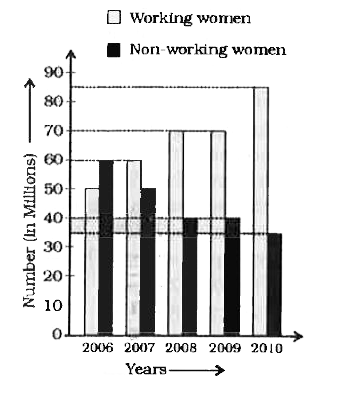Answer the following question , which help you understand the difference between Thomson's model and Rutherford's model better.
In Which model is it completely wrong to ignore multiple scattering for the calculation of average angle of scatterig of α - particles by a thin foil?
It is wrong to ignore multiple scattering in Thomson.s atom because in this model a single collision causes very little deflection. The observed average scattering angle can be explained only by considering multiple scattering.
Topper's Solved these Questions
- BOOK - U-LIKE SERIESCHAPTER - ATOMSEXERCISE - CASE BASED/SOURCE - BASED INTERGRATED QUESTIONS10videos
ATOMS
- BOOK - U-LIKE SERIESCHAPTER - ATOMSEXERCISE - MULTIPLE CHOICE QUESTIONS30videos
ATOMS
- BOOK - U-LIKE SERIESCHAPTER - ATOMSEXERCISE - SELF ASSESSMENT TEST (SECTION C)2videos
ATOMS
- BOOK - U-LIKE SERIESCHAPTER - ALTERNATING CURRENT EXERCISE - SELF ASSESSMENT TEST (SECTION -C)2videos
ALTERNATING CURRENT
- BOOK - U-LIKE SERIESCHAPTER - CBSE EXAMINATION PAPER 2020 EXERCISE - SECTION D12videos
CBSE EXAMINATION PAPER 2020
Similar Questions
Answer the following questions, which help you understand the difference between Thomson’s model and Rutherford’s model better.
(a) Is the average angle of deflection of -particles by a thin gold foil predicted by Thomson’s model much less, about the same, or much greater than that predicted by Rutherford’s model?
(b) Is the probability of backward scattering (i.e., scattering of α-particles at angles greater than 90°) predicted by Thomson’s model much less, about the same, or much greater than that predicted by Rutherford’s model?
(c) Keeping other factors fixed, it is found experimentally that for small thickness t, the number of α-particles scattered at moderate angles is proportional to t. What clue does this linear dependence on t provide?
(d) In which model is it completely wrong to ignore multiple scattering for the calculation of average angle of scattering of α -particles by a thin foil?View SolutionAnswer the following questions, which help you understand the difference between Thomson’s model and Rutherford’s model better.
(a) Is the average angle of deflection of -particles by a thin gold foil predicted by Thomson’s model much less, about the same, or much greater than that predicted by Rutherford’s model?
(b) Is the probability of backward scattering (i.e., scattering of α-particles at angles greater than 90°) predicted by Thomson’s model much less, about the same, or much greater than that predicted by Rutherford’s model?
(c) Keeping other factors fixed, it is found experimentally that for small thickness t, the number of α-particles scattered at moderate angles is proportional to t. What clue does this linear dependence on t provide?
(d) In which model is it completely wrong to ignore multiple scattering for the calculation of average angle of scattering of α -particles by a thin foil?View Solution
Knowledge Check
- Question 1 - Select One
Observe the graph below and answer the following question.

In which year the difference between average prices of petrol and Diesel is minimum?A2005B2009C2014D2004 - Question 2 - Select One
Study the following multiple bar graph carefully and answer the questions.

In which year or years, the difference between the number of working and non-working women the lowest ?A2006 and 2007B2007 and 2008COnly 2006DOnly 2007 - Question 3 - Select One
Rutherford.s α-ray scattering experiment led to the discovery of the nucleus and to the conclusion that an atom consists of large empty space. Arrange the following steps in a sequence which explains the experiment and also the above mentioned conclusions.
(1) To make out the observations a spherical ZnS screen was placed surrounding the gold foil.
(2) The substance which acts as a source of α-particles is taken in a lead container and made to pass through a slit between like charged positive plates.
(3) It was observed that most of the particles passed straight through the gold foil, few were deflected through small angles and very few through large angles. However, very few completely rebounded.
(4) A norrow , condensed beam consisting of α- particles is made to bombard on a thin gold foil.A1 3 2 4B2 3 1 4C4 2 1 3D2 4 1 3
Answer the following question , which help you understand the difference between Thomson's model and Rutherford's model better.
Is the probaility of backward scattering (i.e., scattering of α - particle at angles greater than 90∘) perdicted by Thomsom's model much less , about the same , or much greater than the predicted by Thomson'n model much less , about the same , or much greater than that predicted by Rutheford's model ?View SolutionAnswer the following question , which help you understand the difference between Thomson's model and Rutherford's model better.
Is the average angle of deflection of a particles by a thin gold foil predicted by Thomson's model much less, about the same, or much greater than that predicted by Rutherford's model ?View SolutionAnswer the following question , which help you understand the difference between Thomson's model and Rutherford's model better.
Keeping other factors fixed, it is found experimentally that for small thickness t, the number of α - particles scatterd at moderate angles is proportional to t. What due does this linear dependence on t provide ?View SolutionObserve the graph below and answer the following question

In which year the difference between average prices of petrol and Diesel is minimum?View SolutionRead the following passage and then answer questions (a) - (e) on the basis of your understanding of the passage and the related studied concepts.
Rutherford was the pioneer who established the existence of the atomic nucleus. Result of Geiger and Marsden experiment on the scattering of a-particles from thin gold foils, performed at Rutherford’s suggestion, revealed that the distance of closest approach to a gold nucleus of an a-particle of kinetic energy 5.5 MeV is about 4.0×10−14m. The said scattering effect was explained by Rutherford by assuming that the Coulombian repulsive force was solely responsible for scattering. Since the positive charge is confined to the nucleus, the actual size of the nucleus has to be less than 4.0×10−14m.
If we use a-particles of higher energies, the distance of closest approach to the gold nucleus will be still smaller. At some point the scattering will begin to be affected by the short range nuclear forces and differ from Rutherford’s calculations. From the distance at which deviations set it, nuclear size can be inferred.
(a) Define MeV and express its value in terms of SI unit of energy.
(b) What is distance of closest approach ?
(c) Write an expression for distance of closest approach of a-particle to a gold nucleus.
(d) What was Rutherford’s hypothesis regarding the existence of the atomic nucleus ?
(e) How can you show that volume of the nucleus of an element is proportional to its mass number ?View Solution

